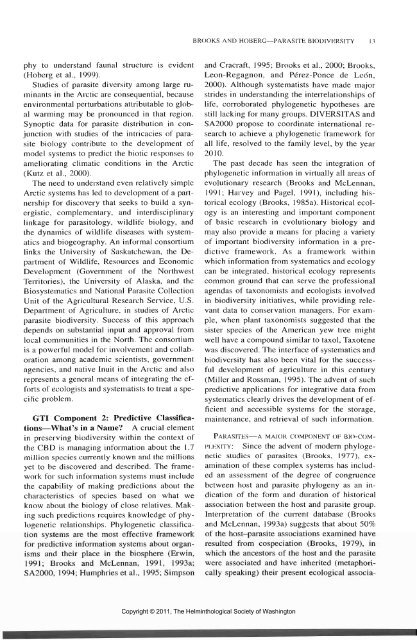Comparative Parasitology 67(1) 2000 - Peru State College
Comparative Parasitology 67(1) 2000 - Peru State College
Comparative Parasitology 67(1) 2000 - Peru State College
Create successful ePaper yourself
Turn your PDF publications into a flip-book with our unique Google optimized e-Paper software.
phy to understand faunal structure is evident<br />
(Hoberg et al., 1999).<br />
Studies of parasite diversity among large ruminants<br />
in the Arctic are consequential, because<br />
environmental perturbations attributable to global<br />
warming may be pronounced in that region.<br />
Synoptic data for parasite distribution in conjunction<br />
with studies of the intricacies of parasite<br />
biology contribute to the development of<br />
model systems to predict the biotic responses to<br />
ameliorating climatic conditions in the Arctic<br />
(Kutz et al., <strong>2000</strong>).<br />
The need to understand even relatively simple<br />
Arctic systems has led to development of a partnership<br />
for discovery that seeks to build a synergistic,<br />
complementary, and interdisciplinary<br />
linkage for parasitology, wildlife biology, and<br />
the dynamics of wildlife diseases with systematics<br />
and biogeography. An informal consortium<br />
links the University of Saskatchewan, the Department<br />
of Wildlife, Resources and Economic<br />
Development (Government of the Northwest<br />
Territories), the University of Alaska, and the<br />
Biosystematics and National Parasite Collection<br />
Unit of the Agricultural Research Service, U.S.<br />
Department of Agriculture, in studies of Arcticparasite<br />
biodiversity. Success of this approach<br />
depends on substantial input and approval from<br />
local communities in the North. The consortium<br />
is a powerful model for involvement and collaboration<br />
among academic scientists, government<br />
agencies, and native Inuit in the Arctic and also<br />
represents a general means of integrating the efforts<br />
of ecologists and systematists to treat a specific<br />
problem.<br />
GTI Component 2: Predictive Classifications—What's<br />
in a Name? A crucial element<br />
in preserving biodiversity within the context of<br />
the CBD is managing information about the 1.7<br />
million species currently known and the millions<br />
yet to be discovered and described. The framework<br />
for such information systems must include<br />
the capability of making predictions about the<br />
characteristics of species based on what we<br />
know about the biology of close relatives. Making<br />
such predictions requires knowledge of phylogenetic<br />
relationships. Phylogenetic classification<br />
systems are the most effective framework<br />
for predictive information systems about organisms<br />
and their place in the biosphere (Erwin,<br />
1991; Brooks and McLennan, 1991, 1993a;<br />
SA<strong>2000</strong>, 1994; Humphries et al., 1995; Simpson<br />
BROOKS AND HOBKRG—PARASITE BIODIVKRSITY<br />
and Cracraft, 1995; Brooks et al., <strong>2000</strong>; Brooks,<br />
Leon-Regagnon, and Perez-Ponce de Leon,<br />
<strong>2000</strong>). Although systematists have made major<br />
strides in understanding the interrelationships of<br />
life, corroborated phylogenetic hypotheses are<br />
still lacking for many groups. DIVERSITAS and<br />
SA<strong>2000</strong> propose to coordinate international research<br />
to achieve a phylogenetic framework for<br />
all life, resolved to the family level, by the year<br />
2010.<br />
The past decade has seen the integration of<br />
phylogenetic information in virtually all areas of<br />
evolutionary research (Brooks and McLennan,<br />
1991; Harvey and Pagel, 1991), including historical<br />
ecology (Brooks, 1985a). Historical ecology<br />
is an interesting and important component<br />
of basic research in evolutionary biology and<br />
may also provide a means for placing a variety<br />
of important biodiversity information in a predictive<br />
framework. As a framework within<br />
which information from systematics and ecology<br />
can be integrated, historical ecology represents<br />
common ground that can serve the professional<br />
agendas of taxonomists and ecologists involved<br />
in biodiversity initiatives, while providing relevant<br />
data to conservation managers. For example,<br />
when plant taxonomists suggested that the<br />
sister species of the American yew tree might<br />
well have a compound similar to taxol, Taxotene<br />
was discovered. The interface of systematics and<br />
biodiversity has also been vital for the successful<br />
development of agriculture in this century<br />
(Miller and Rossman, 1995). The advent of such<br />
predictive applications for integrative data from<br />
systematics clearly drives the development of efficient<br />
and accessible systems for the storage,<br />
maintenance, and retrieval of such information.<br />
PARASITKS—A MAJOR COMPONENT OF BIO-COM-<br />
PLHXITY: Since the advent of modern phylogenetic<br />
studies of parasites (Brooks, 1977), examination<br />
of these complex systems has included<br />
an assessment of the degree of congruence<br />
between host and parasite phylogeny as an indication<br />
of the form and duration of historical<br />
association between the host and parasite group.<br />
Interpretation of the current database (Brooks<br />
and McLennan, 1993a) suggests that about 50%<br />
of the host—parasite associations examined have<br />
resulted from cospeciation (Brooks, 1979), in<br />
which the ancestors of the host and the parasite<br />
were associated and have inherited (metaphorically<br />
speaking) their present ecological associa-<br />
Copyright © 2011, The Helminthological Society of Washington
















